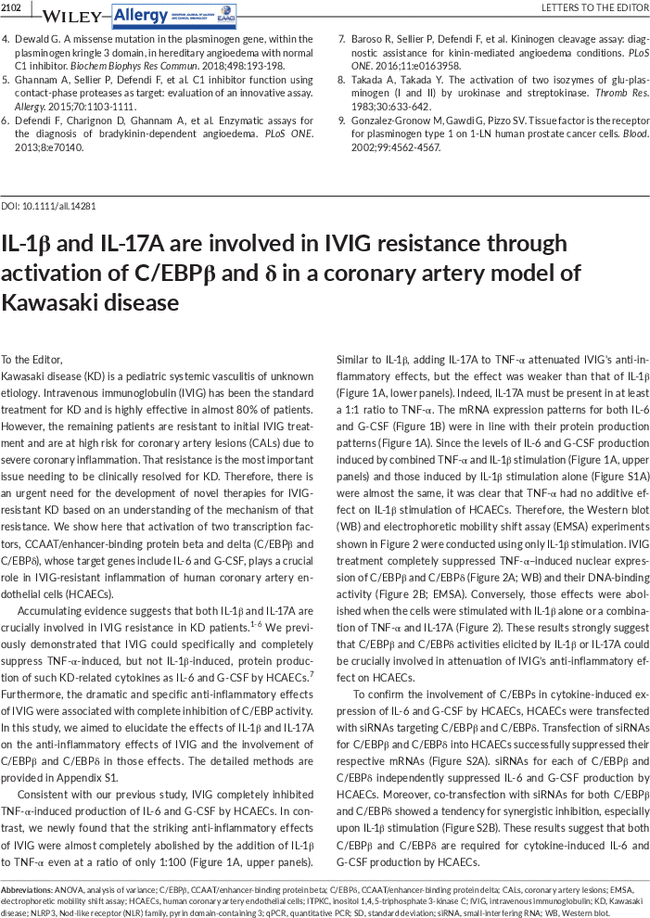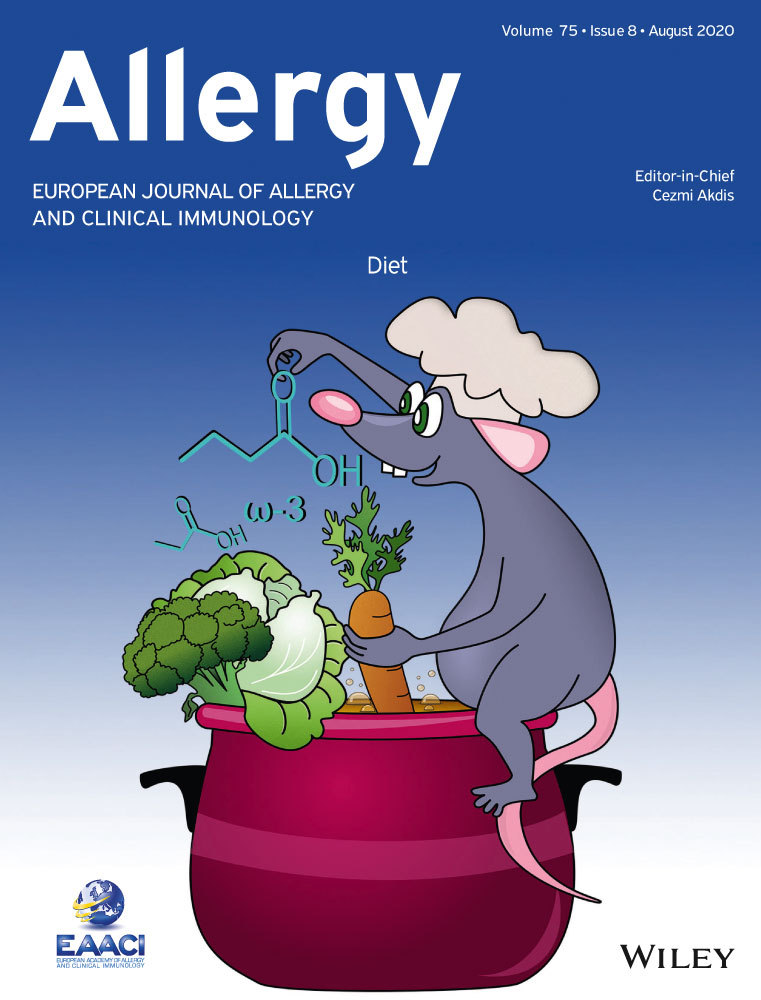IL-1β and IL-17A are involved in IVIG resistance through activation of C/EBPβ and δ in a coronary artery model of Kawasaki disease
Takashi Inoue
Department of Allergy and Clinical Immunology, National Research Institute for Child Health and Development, Tokyo, Japan
Department of Pediatrics, Jikei University School of Medicine, Tokyo, Japan
Search for more papers by this authorMasaki Miyashita
Department of Allergy and Clinical Immunology, National Research Institute for Child Health and Development, Tokyo, Japan
Search for more papers by this authorShokei Murakami
Department of Allergy and Clinical Immunology, National Research Institute for Child Health and Development, Tokyo, Japan
Department of Pediatrics, Toyama University School of Medicine, Toyama, Japan
Search for more papers by this authorArisa Igarashi
Department of Allergy and Clinical Immunology, National Research Institute for Child Health and Development, Tokyo, Japan
Search for more papers by this authorKenichiro Motomura
Department of Allergy and Clinical Immunology, National Research Institute for Child Health and Development, Tokyo, Japan
Search for more papers by this authorJun Abe
Department of Advanced Medicine for Infections, National Research Institute for Child Health and Development, Tokyo, Japan
Search for more papers by this authorKenji Matsumoto
Department of Allergy and Clinical Immunology, National Research Institute for Child Health and Development, Tokyo, Japan
Search for more papers by this authorCorresponding Author
Akio Matsuda
Department of Allergy and Clinical Immunology, National Research Institute for Child Health and Development, Tokyo, Japan
Correspondence
Akio Matsuda, Department of Allergy and Clinical Immunology, National Research Institute for Child Health and Development, 2-10-1 Okura, Setagaya-ku, 157-8535, Tokyo, Japan.
Email: [email protected]
Search for more papers by this authorTakashi Inoue
Department of Allergy and Clinical Immunology, National Research Institute for Child Health and Development, Tokyo, Japan
Department of Pediatrics, Jikei University School of Medicine, Tokyo, Japan
Search for more papers by this authorMasaki Miyashita
Department of Allergy and Clinical Immunology, National Research Institute for Child Health and Development, Tokyo, Japan
Search for more papers by this authorShokei Murakami
Department of Allergy and Clinical Immunology, National Research Institute for Child Health and Development, Tokyo, Japan
Department of Pediatrics, Toyama University School of Medicine, Toyama, Japan
Search for more papers by this authorArisa Igarashi
Department of Allergy and Clinical Immunology, National Research Institute for Child Health and Development, Tokyo, Japan
Search for more papers by this authorKenichiro Motomura
Department of Allergy and Clinical Immunology, National Research Institute for Child Health and Development, Tokyo, Japan
Search for more papers by this authorJun Abe
Department of Advanced Medicine for Infections, National Research Institute for Child Health and Development, Tokyo, Japan
Search for more papers by this authorKenji Matsumoto
Department of Allergy and Clinical Immunology, National Research Institute for Child Health and Development, Tokyo, Japan
Search for more papers by this authorCorresponding Author
Akio Matsuda
Department of Allergy and Clinical Immunology, National Research Institute for Child Health and Development, Tokyo, Japan
Correspondence
Akio Matsuda, Department of Allergy and Clinical Immunology, National Research Institute for Child Health and Development, 2-10-1 Okura, Setagaya-ku, 157-8535, Tokyo, Japan.
Email: [email protected]
Search for more papers by this author
Supporting Information
| Filename | Description |
|---|---|
| all14281-sup-0001-Supinfo.docxWord document, 6.4 MB | Supplementary Material |
Please note: The publisher is not responsible for the content or functionality of any supporting information supplied by the authors. Any queries (other than missing content) should be directed to the corresponding author for the article.
REFERENCES
- 1Fury W, Tremoulet AH, Watson VE, et al. Transcript abundance patterns in Kawasaki disease patients with intravenous immunoglobulin resistance. Hum Immunol. 2010; 71: 865-873.
- 2Weng KP, Hsieh KS, Ho TY, et al. IL-1B polymorphism in association with initial intravenous immunoglobulin treatment failure in Taiwanese children with Kawasaki disease. Circ J. 2010; 74: 544-551.
- 3Alphonse MP, Duong TT, Shumitzu C, et al. Inositol-triphosphate 3-kinase C mediates inflammasome activation and treatment response in Kawasaki disease. J Immunol. 2016; 197: 3481-3489.
- 4Burns JC, Koné-Paut I, Kuijpers T, Shimizu C, Tremoulet A, Arditi M. Found in translation: international initiatives pursuing interleukin-1 blockade for treatment of acute Kawasaki disease. Arthritis Rheumatol. 2017; 69: 268-276.
- 5Guo MM, Tseng WN, Ko CH, Pan HM, Hsieh KS, Kuo HC. Th17- and Treg-related cytokine and mRNA expression are associated with acute and resolving Kawasaki disease. Allergy. 2015; 70: 310-318.
- 6Jia S, Li C, Wang G, et al. The T helper type 17/regulatory T cell imbalance in patients with acute Kawasaki disease. Clin Exp Immunol. 2010; 162: 131-137.
- 7Matsuda A, Morita H, Unno H, et al. Anti-inflammatory effects of high-dose IgG on TNF-α-activated human coronary artery endothelial cells. Eur J Immunol. 2012; 42: 2121-2131.
- 8Onouchi Y, Gunji T, Burns JC, et al. ITPKC functional polymorphism associated with Kawasaki disease susceptibility and formation of coronary artery aneurysms. Nat Genet. 2008; 40: 35-42.
- 9Kong WX, Ma FY, Fu SL, et al. Biomarkers of intravenous immunoglobulin resistance and coronary artery lesions in Kawasaki disease. World J Pediatr. 2019; 15: 168-175.




